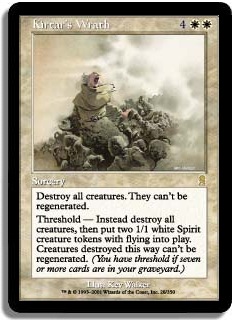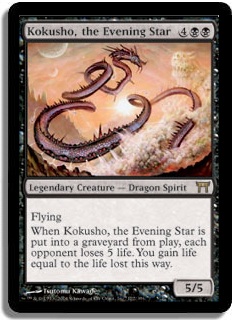Do you enjoy Commander? Do you enjoy smashing the face of nameless hordes of bad guys in video games? Well, get ready to enjoy Horde Magic!
It’s been a while since I’ve seen anyone discuss Horde Magic online. What happened? It was the adjunct du jour for Commander for a few months, and then it fell off the planet. Well, I still like you, Horde Magic. Yes I do, yes I do (in my best speaking-to-dog voice)!
I’ve wanted to build a few more Hordes recently since the artifact one I had in real life was getting old.
While Zombies are a pretty obvious go-to tribe, I thought that a few other tribes should get some Horde love. So today I have built a Spirit Horde for your consideration.
What is Horde? Excellent question!
Horde Magic uses the rules and decks from Commander, but instead of fighting each other a la multiplayer chaos style, you are teaming up against the nasty Horde. You win once the Horde deck has exhausted its deck—which represents its life. Damage dealt to our Horde friend results in it milling an equal number of cards from its library to its graveyard.
Here are some quick rules for Horde Magic:
The game is sort of like Two-Headed Giant with many heads. But you take just one shared turn, attack just once, and block just once. You have a shared life total for the Horde to attack, typically in the 40-60 range. You get to take free turns at the beginning of the game before the Horde onslaught begins to help you set up. The fewer players (than four) you have, the smaller the Horde stack begins the game. Then you have a Horde turn.
The Horde turn is odd. For each turn, you flip over cards until you flip over a nontoken. All cards and tokens are played for free—no mana for the Horde. Then the Horde must attack with all of its creatures, and they all have haste. If the Horde must make a choice because of something like, say a Truth or Tale targeting it, the choices are made randomly. Now, one quirky rule: all token cards for the Horde are treated as normal cards. They are bounced, go to the graveyard, deck, etc. If a card goes into the Horde’s hand after the beginning of its main phase, it stays there until the beginning of the next turn after it draws and dumps everything.
There are a lot more quirks and discussions about the rule. This is basically just a reminder for readers out there. If you have not encountered Horde before, you can check out rules here, and you can find articles discussing it in the Appendix.
Whether or not this is your first go around with Horde Magic, now we’ve discussed the rules and concept a bit. You play with each other against the vile Horde. Rar! Let’s look at my Spirit Horde.
Spirit Horde
3 Battleground Geist
2 Drogskol Captain
2 Gallows Warden
2 Geist-Honored Monk
1 Spirit of the Night
1 Ryusei, the Falling Star
1 Kokusho, the Evening Star
2 Kindercatch
1 Ashen Monstrosity
1 Drogskol Reaver
1 Kodama of the North Tree
1 Nobilis of War
1 Phantom Nishoba
1 Windborn Muse
1 Latch Seeker
1 Honden of Life’s Web
2 Aether Shockwave
2 Kirtar’s Wrath
2 Long-Forgotten Gohei
2 Lingering Souls
1 Promise of Bunrei
1 Spirit Cairn
2 Spectral Procession
1 True Conviction
1 Glorious Anthem
1 Favorable Winds
1 Gravitational Shift
1 Sleep
1 Twilight’s Call
60 Spirit Tokens (all 1/1 flyers)
Alright, this Spirit Horde is ready to rock the block with its rockingness.
When looking at the differences between Spirit tokens and Zombie tokens, you can spy a clear disadvantage for Spirit tokens in terms of power and toughness. The Zombie deck typically runs a slew of 2/2 Zombies plus a few 5/5 Zombie Giants. (A slew and a few. That’s my unintentional rhyme quotient for the day!) My only Spirit options involved choosing between 1/1 Spirits in the air or 1/1 Spirits on the ground (from Kamigawa block). That’s it! So I am running all 60 tokens with flying. Now, that means my many tokens do have some built-in evasion, which is nice. But they also have some built-in weaknesses.
I added some Spirit enablers first. Having Lords in just about any Horde deck is crucial. So I am rocking two Drogskol Captains plus Battleground Geist and Gallows Warden. The problem with the Captain is that he grants hexproof to my tokens—which hurts opposing ways of handling it. You have to handle him first. I also had Kira, Great Glass Spinner in my deck for a bit, but I felt it was too much.
I wanted some cards to pump my team, but I also wanted to steer clear of cards that made no sense flavor-wise. For example, I didn’t want my team fighting under an Orcish Oriflamme, and I didn’t feel like Beastmaster’s Ascension would be a good fit. I would need an Orc or Goblin Horde for the former and maybe a Beast or Animal Horde for the latter.
Instead, I added copies of cards like Glorious Anthem and True Conviction. I felt that both were sufficiently vague in nomenclature to warrant their inclusion. I also wanted some flying enablers, so in went Favorable Winds and Gravitational Shift. Long-Forgotten Gohei was an obvious pump card as well.
Some Hordes run sweepers, and I felt that Kirtar’s Wrath, which leaves behind a pair of Spirits if you have threshold (and you will have threshold) was a great match. I also believe that every Horde should run at least one Twilight’s Call for the animosity of a graveyard furor. I enjoyed the connection of quasi-substantial Spirits and that time of day between day and night when things seem spectral.
With some great Spirit token makers out there, I also liked the idea of some cards that make Spirits. In went cards like Lingering Souls and Spectral Procession. Assume the Horde will automatically flashback the spell to get two goes and four tokens. I loved the Honden of Life’s Web for this deck because it spits out one Spirit token for free every turn—even if it doesn’t fly.
Also assume that the Horde player always chooses to tap all non-Spirits with Aether Shockwave. I gave the deck a more powerful Sleep, which is downright abusive in a Horde deck. Watch out for those tappers!
One of the interesting decisions you have to make when building any Horde deck is what other creatures are included beyond Lords. Geist-Honored Monk brings a few Spirits to the party upon arrival and swings for a lot of damage, so I felt that was a good choice. But the GHM is really a Spirit enabler of a different sort. What about those creatures which are not enablers?
I wanted a few serious Spirits of size since we didn’t have any larger token creatures in the pool like 5/5 Zombie Giant tokens. My first choice was the massively powerful Spirit of the Night. That thing has sauce! I wanted the legendary Dragon Spirits from Champions of Kamigawa, but only two were able to be played. The other three each require a choice (Jugan’s counters, Yosei’s tapped permanents, and Keiga’s stolen creature).
Still, injecting this deck with Kokusho and Ryusei was great. I especially enjoyed added Ryusei, and for a while I had a second copy because he’s great in a deck where the Horde and creatures mostly fly. Kodama of the North Tree was the final legendary Spirit that made the cut, with its 6/4 trampling shroud self giving the deck another injection of size.
I added some fun creatures like Ashen Monstrosity and Kindercatch. I initially added four Kindercatch to the deck, seeing them as good replacements for Zombie Giant tokens, but because they stopped the Horde from dropping anything further that turn, they were a poor substitute, so I rolled back the Kindercatch level to two. After that, I saw Nobilis of War, and since it pumped my team when it attacked, I knew it was another great enabler for my Spirit assault.
The last four Spirits added were the potent Drogskol Reaver, big ground pounder Phantom Nishoba, quirky Windborn Muse, and unblockable Latch Seeker.
With the various tricks this deck can unleash, it can unload some serious Hordey fun on your friends and foes alike! I tried to stay clear of too many enablers that were not Spirit specific. If you have too many True Conviction, Collective Blessing, or Glorious Anthem, it can feel a bit homogeneous with other Hordes. I wanted this Horde stack to be a Spirit stack through and through. You can still have a few of those sorts of cards for spice, but the Horde needs to stand on its own flavor. I hope to have accomplished that here.
Building Horde decks is fun, but playing is even more fun! If you’ve gotten out of the habit of Horde, it’s time to pick it back up again for your next Commander night. And if you’ve never tried, why not build a Horde now and rock one to experiment with? Maybe it will be something you add permanently to your rotation of decks and formats.
I hope that you enjoyed the Spirit Horde of love! Next week, we will be looking at my Commander Cube list and discussing it, which should be a lot of fun, so check you out then!
Until later,
Abe Sargent
Appendix: A Few Links to Other Hordes
My Germ Horde Deck
[author name="Sheldon Menery"]Sheldon Menery[/author] on Horde Magic
Adam Styborski on Playing Horde Magic
Robby Rothe on Horde Magic






